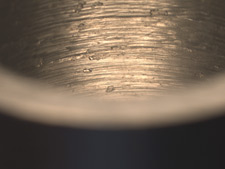Home | Glossary | Resources | Help | Contact Us | Course Map
Archival Notice
This is an archive page that is no longer being updated. It may contain outdated information and links may no longer function as originally intended.
Other Cutting Operations
Other cutting operations include the following:
- Shaping - a single-point cutting machine cuts in a straight line by repeated parallel strokes, gradually moving across a flat surface.
- Planing - similar to shaping, but the workpiece moves under a stationary cutting tool.
- Drilling - a cylindrical cutting tool with multiple fluted cutting edges arrayed in a spiral (e.g., the interior of the barrel of a firearm).
- Reaming - a cutting technique that it is sometimes used after drilling to produce accurate finely finished holes.
- Broaching - multitooth cutting tool that moves against a stationary workpiece. It can remove metal on both interior and exterior surfaces. Each tooth cuts slightly deeper than the previous one and removes only a small thickness of metal. A cylindrical broach is one type of tool used to put rifling in the barrel of a firearm.
- Sawing - a multitoothed cutting tool in which the cutting edges are arranged in line.
- Filing - material is formed and removed using teeth that are shallow and broad (the reverse of a saw blade).
- Abrasive machining - thousands of tiny cutting edges made up of individual abrasive grains and used as a finishing operation. Each abrasive grain removes a minute amount of material. Abrasive machining includes simple grinding, lapping, tumbling, and numerous other specialized applications of abrasives.
See the YouTube Terms of Service and Google Privacy Policy
Additional Online Courses
- What Every First Responding Officer Should Know About DNA Evidence
- Collecting DNA Evidence at Property Crime Scenes
- DNA – A Prosecutor’s Practice Notebook
- Crime Scene and DNA Basics
- Laboratory Safety Programs
- DNA Amplification
- Population Genetics and Statistics
- Non-STR DNA Markers: SNPs, Y-STRs, LCN and mtDNA
- Firearms Examiner Training
- Forensic DNA Education for Law Enforcement Decisionmakers
- What Every Investigator and Evidence Technician Should Know About DNA Evidence
- Principles of Forensic DNA for Officers of the Court
- Law 101: Legal Guide for the Forensic Expert
- Laboratory Orientation and Testing of Body Fluids and Tissues
- DNA Extraction and Quantitation
- STR Data Analysis and Interpretation
- Communication Skills, Report Writing, and Courtroom Testimony
- Español for Law Enforcement
- Amplified DNA Product Separation for Forensic Analysts


